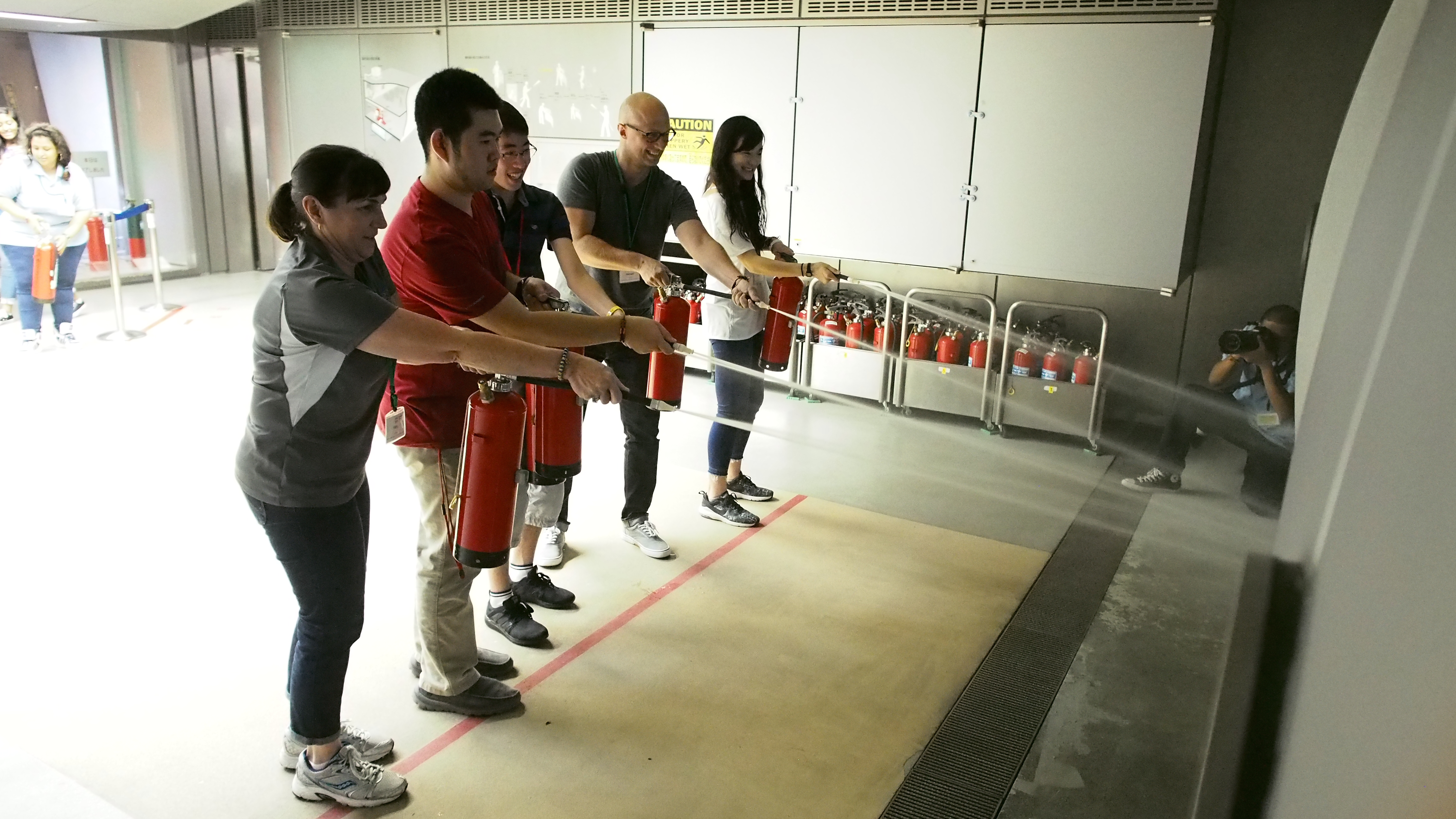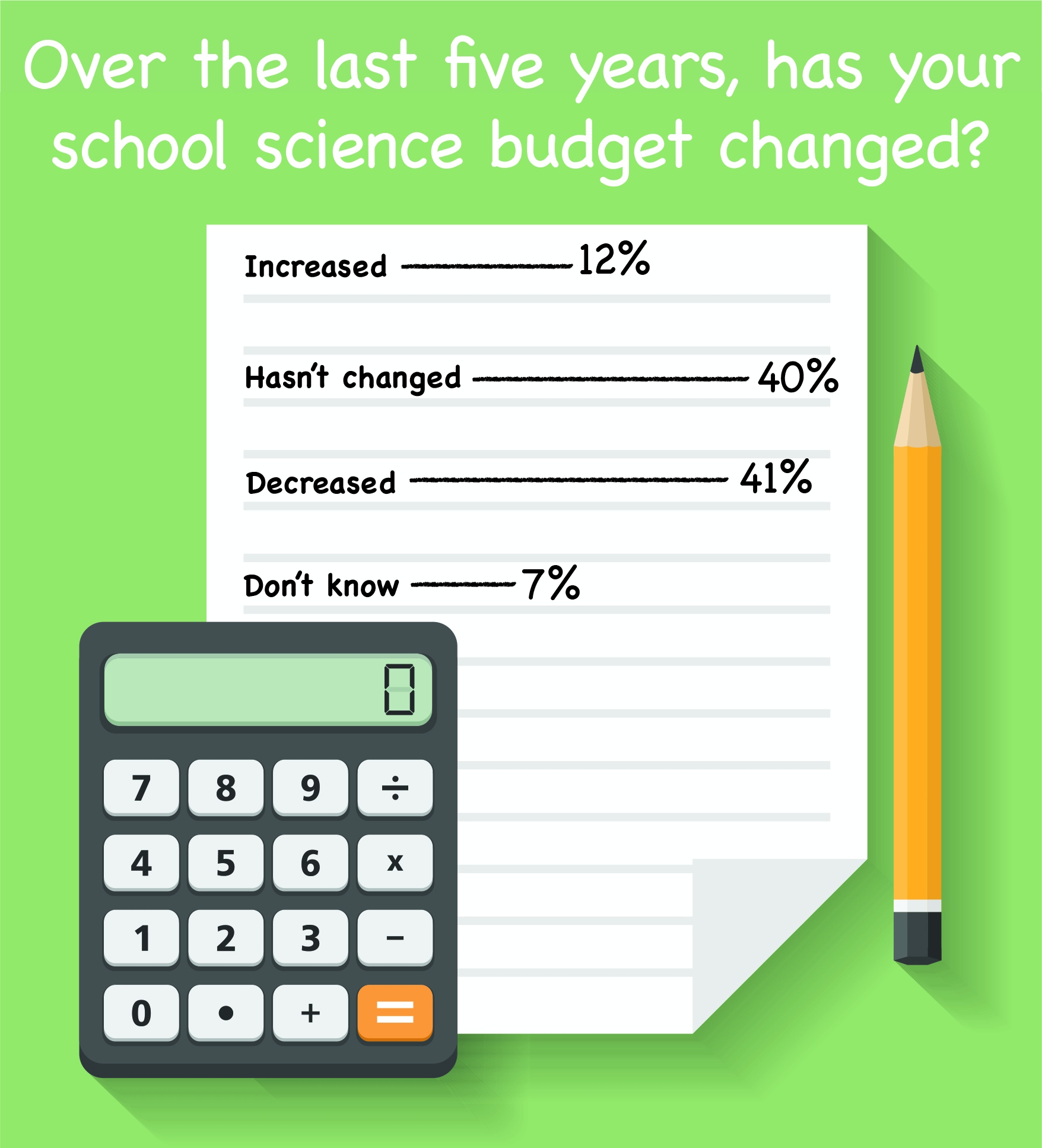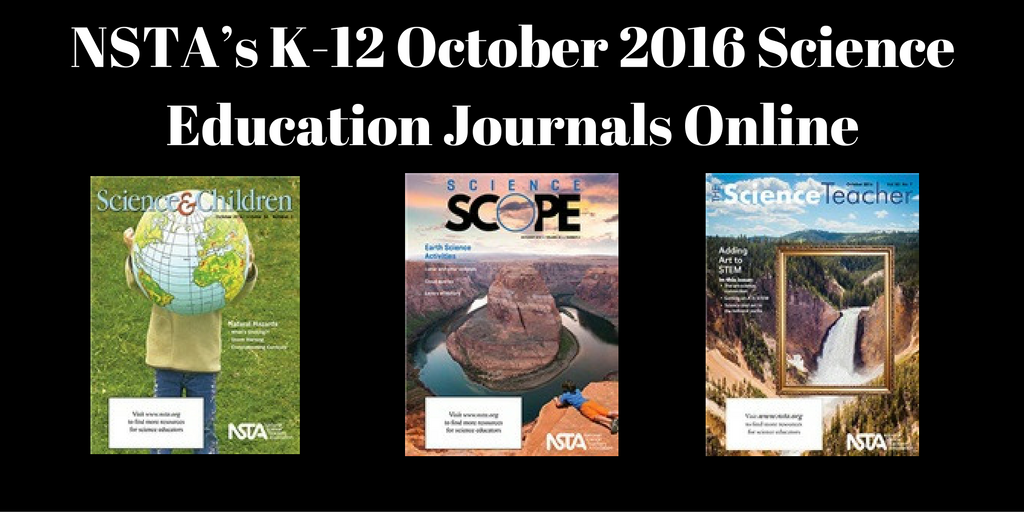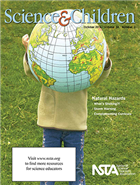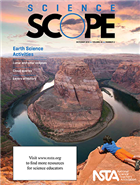Two New NSTA Kids Books Highlight Importance of Observation
By Carole Hayward
Posted on 2016-10-07
Two new children’s books published by NSTA Kids, a division of NSTA Press, are filled with rich illustrations and highlight the importance of discovery, observation, and investigation.
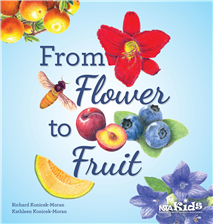 In From Flower to Fruit, young scientists are encouraged to use a magnifying glass to study plants in a garden. The book, intended for grades K–4, takes readers on a colorful journey that teaches them about flowers, fruits, and bees, and how plants have special parts that help them reproduce.
In From Flower to Fruit, young scientists are encouraged to use a magnifying glass to study plants in a garden. The book, intended for grades K–4, takes readers on a colorful journey that teaches them about flowers, fruits, and bees, and how plants have special parts that help them reproduce.
The authors, Richard Konicek-Moran and Kathleen Konicek-Moran, write that flowers can provide “great teaching and learning opportunities for all ages,” and that botany is underrated as a topic for investigation because it is often considered a categorizing science. “We hope this book will introduce the discovery and wonder of botany,” the authors write.
In addition to the story, the authors include six activities for children and informative background information for parents and teachers. The book comes alive with beautiful and helpful drawings, illustrated by coauthor Kathleen Konicek-Moran. These detailed illustrations reinforce the role observation plays in science. “When you draw something, you look very closely at it and see things you might have missed if you were not drawing it,” Mrs. Maria—one of the story’s characters—says in the book.
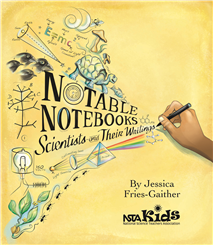 Sketching, writing, and recording data and observations is also a major theme of the other new NSTA Kids book—Notable Notebooks: Scientists and Their Writings. The author, Jessica Fries-Gaither, captures why journaling is such an important part of the scientific process.
Sketching, writing, and recording data and observations is also a major theme of the other new NSTA Kids book—Notable Notebooks: Scientists and Their Writings. The author, Jessica Fries-Gaither, captures why journaling is such an important part of the scientific process.
The book, written in rhyme for grades 3–5, profiles a diverse group of nine scientists (both modern day and past) and provides examples of their writings and illustrations. Dr. Jane Goodall is shown studying drawings of chimps in her notebook, Galileo’s diagram of planetary orbits is featured, and a section on Charles Henry Turner displays how his notes uncovered patterns in insect behavior. “A notebook is a place to plan experiments or tests and also to see patterns in what data could suggest,” the author writes.
Notable Notebooks includes four steps to help students create their own science notebooks. The steps encourage students to write down their findings and wonderings and share their work with family, friends, or teachers at school. “What makes a notebook special? It’s a place to think and dream, to write down thoughts and questions about all that you have seen,” Fries-Gaither writes.
Fall for These Savings on NSTA Press Books!
Between now and November 1, 2016, save $15 off your order of $75 or more of NSTA Press books or e-books by entering promo code BKS16 at checkout in the online Science Store. Offer valid only on orders placed of NSTA Press books or e-books on the web and may not be combined with any other offer.
Follow NSTA
Save
Two new children’s books published by NSTA Kids, a division of NSTA Press, are filled with rich illustrations and highlight the importance of discovery, observation, and investigation.
Weather watching
By Peggy Ashbrook
Posted on 2016-10-06

This visible image on Oct. 6 at 1:00 p.m. EDT from NOAA’s GOES-East satellite shows Hurricane Matthew as it regained Category 4 Hurricane Status.
Credits: NASA/NOAA GOES Project
As Hurricane Matthew traveled across the Caribbean and into the Atlantic, I think of how children who live in its path and those at a distance will make sense of the force of this extreme weather event. Science education can sometimes mean talking about scary or tragic events. Be sensitive to fears and stress by asking families about children’s previous experiences with natural disasters such as the flooding in Louisiana and West Virginia this past summer.
Even with relatively minor flooding events, children have questions such as, “What happens when water goes or stays where we don’t want it?” When localized flooding due to a plugged county drain affected just their building, children in the Frog Pond Early Learning Center in Fairfax County, Virginia, wanted to understand the process and talk about how to prevent it. Gail Dickert, Executive Director of the non-profit, said that the flooding led to stronger relationships with and between families. For the five weeks of cleanup after the county line backed up and poured sewage into their building, the school helped some families make other arrangements and created a combined age classroom for children 18 months to 5 years old for others. The children missed being with their usual friends but were curious about “how and why.” They were interested in finding solutions because they were displaced from their usual routines.
Resources for adults to help young children cope with violence and tragedies include The Fred Rogers Company article about tragic events. Mr. Rogers said, “In times of crisis, children want to know, ‘Who will take care of me?’…They also need to hear that people in the government and other grownups they don’t even know are working hard to keep them safe, too.” “Other grownups” includes teachers!
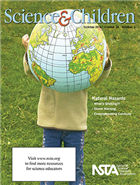 Resources for understanding weather events of all kinds includes the October issue of Science and Children with “Storm Warning,” a free feature article by Tammy Lee, Meredith Kier, and Kelsey Phillips, and these additional resources:
Resources for understanding weather events of all kinds includes the October issue of Science and Children with “Storm Warning,” a free feature article by Tammy Lee, Meredith Kier, and Kelsey Phillips, and these additional resources:
“Science Shorts: Weather Watchers,” in the April 2011 Science and Children by Sami Kahn.
The CoCoRaHS School Pilot Program for collecting data, a project of the Community Collaborative Rain, Hail and Snow Network.
Hurricanes! by Gail Gibbons. 2009. Holiday House.
Hurricanes by Seymore Simon. 2007. HarperCollins.
Ready, Set…WAIT! by Patti R. Zelch, Illustrated by Connie McLennan. 2009. Arbordale.
Partnering With Utilities for Hands-On STEM
By Lynn Petrinjak
Posted on 2016-10-06

Granada High School’s Interact Club students work with David Lunn of Friends of the Arroyo to measure water turbidity during the Tri-Valley Creeks to Bay Clean-up event. Photo by William Rasor.
Utility companies, hoping to inspire the next generation of employees, meet community outreach and other obligations, or both, are teaming up with educators to create innovative, hands-on learning opportunities.
Keri Randolph, director of innovation for Hamilton County Schools in Tennessee, has worked with two utility companies—the Tennessee Valley Authority (TVA) and the local electric power board (EPB)—to expand science, technology, engineering, and mathematics (STEM) offerings for Hamilton County students. TVA’s Partners in Education program supports initiatives including robotics and energy-focused supports, such as donating solar arrays and other equipment.
Her work with the EPB grew out of a casual conversation with an EPB employee about the challenge of marketing a community solar energy program. That led to a meeting with EPB and K–12 teachers from six Hamilton County schools who brainstormed project- based learning ideas based on the program. Randolph reports that each grade level took a different approach, and in the end, “the kids had a whole package of solutions they presented to EPB.” They included public service announcements created by kindergarten students and a solar power education kiosk designed by high school students.
“EPB has said they will take some ideas and implement them,” she notes. “This has opened up more opportunities for us to partner [with EPB]… At our STEM high school, students do quarterly [projects. When EPB was designing] a new power grid in a new neighborhood, our kids came up with their own plan… that would reduce the number of transformers [needed] and save [EPB] money.”
She says teachers have reported higher student engagement and are requesting more opportunities to partner with utilities and other companies, despite the extra planning time required. “It’s a win-win on both sides,” Randolph notes. “The project-based learning work…came out from casual conversation. I do that a lot more. I ask people if they’ve had kids work on problems; they are pleasantly surprised with the results [when they do].”
The Center for Mathematics, Science, and Technology at Illinois State University (CeMaST) is in its third year of support from the Illinois Science and Energy Innovation Foundation, funded primarily by Illinois power companies to provide K–12 energy education.
“They were probably thinking three-ring binders and PowerPoint slides. We don’t do that,” declares Brad Christensen, CeMaST STEM specialist. Instead, they created a series of rooms—kitchen/dining room, utility room/garage, and bedroom/ bathroom—contained in boxes that can be set up inside a school. In the kitchen, for example, students find all the appliances they would see in a typical kitchen, including a blender, toaster, stove, and refrigerator.
“Students plug things in to see the energy use and calculate the bill. Then they trade the standard [electricity] meter for a smart meter, and get real-time rate adjustments. They get to see what’s most cost-effective, such as using the clothes dryer or oven at off-peak times. We have basically three of every appliance. Every appliance has an Energy Guide tag identifying its energy use as either a low-, middle-, or high-efficiency appliance. Students plug in different appliances with different tags, and see different usages,” says Christensen.
The program has expanded to include a construction set that challenges students to build a working power grid. The curriculum guides them through its construction just as the power grid itself evolved from a “chronological/ historical perspective…Students connect various power plants, transformers, transmission and distribution lines, and meters to form a grid line. They can then combine grid lines to form a complex grid very similar to what we have today, including coal-fired plants, natural gas, renewable [hydroelectric] energy, nuclear, and most lately, a resurgence in wind and solar power,” he explains.
Teachers “download curriculum [from http://cemast.illinoisstate.edu]. All of our curricula are written in a learning cycle format, so [they’re] student-led… The students get the lesson plan and get started doing something immediately… This has really turned out to be good for all of us. Students really understand electrical power, the grid, and how the Smart Grid works,” Christensen asserts.
“The curriculum is not aligned to NGSS [Next Generation Science Standards] or Common Core, but the teachers do [align with them],” he adds, noting the learning cycle “approach aligns with the philosophy of NGSS. I hope we’re having some impact on pedagogy through their use of the learning cycle format.”
When Laura Spence, K–12 STEM specialist for Pinellas County (Florida) Schools, took over the district’s after-school STEM academies, she realized there wasn’t enough funding for all the district schools. She looked at current district partners and ways to expand their collaborations. “I didn’t want to just ask a business partner for money… I felt it was much more important for them to become a vested partner on many different levels,” she recalls. The investment options included sponsoring STEM Family Nights and “teacher learning journeys” at company sites.
STEM Family Night events are opportunities for STEM Academy students and their families to work on engineering projects, now with the assistance from Duke Energy (DE) employees. “The employees work side by side with families and teachers on the engineering design projects, discussing [their role in the community and] their career path,…providing STEM expertise to families [on the project] while also sharing their long-term community goals with the Pinellas County School STEM Academies,” Spence adds. DE also sponsors STEM Learning Journey professional development for STEM Academy teachers and participates in an annual STEM Expo.
“We started four years ago with 56 STEM academies. This year, we have 250 after-school STEM academies,” Spence says. “Having half funded by the district and half funded by [DE], it’s a win-win for our students to have as many STEM opportunities as possible.”
In California, Livermore Valley Joint Unified School District STEM Coordinator Regina Brinker has partnered with the City of Livermore’s Water Resource Division (WRD) to clean trash from local waterways and monitor water quality around the area. On the third Saturday of September, students and their families can join the Tri-Valley Creeks to Bay Clean-up, part of the Adopt a Creek Spot program and Coastal Cleanup Day. WRD selects the cleanup sites, and employees share maps of the local watershed. WRD also provides water-quality test kits.
“We clean up [and quantify] trash… Adding the education component… has impacted students and adults there,” Brinker says. “It brings an element of place-based learning…By working at the creek near our schoolyard, there is higher student engagement.”
Adopt a Creek Spot helps WRD meet permit requirements from the Regional Water Quality Control Board, according to Lynna Allen, WRD water resources coordinator. In addition, the clean-up event is “getting more people involved and raises awareness,” she says. Allen, with partners at the Livermore Area Recreation and Parks Department, Zone 7 Water Agency, and Friends of the Arroyos, also has worked with Brinker and other Livermore teachers to develop K–12 curricula focused on the watershed.
Livermore teachers borrow the water- testing kits from WRD throughout the year to use with their students. “People use test kits as part of World Water Monitoring Day. Kids can look at data worldwide. It fits nicely with NGSS; we look at local data and how does that compare internationally,” Brinker asserts.
Analyzing Utility Data
Data analysis is central to many educator- utility collaborations. In Princeton, New Jersey, Sustainable New Jersey provided a grant to make energy usage data from the elementary, middle, and high schools available to students. The data is streamed online so students can compare power usage among the schools and monitor the impact of any changes, such as replacing windows with more energy-efficient models. In addition, the schools have worked with the Princeton University power plant on projects ranging from energy audits to field trips to the plant. According to Edward Cohen, supervisor of science preK–12 for Princeton Public Schools, “When doing an energy audit, the idea is to have kids present to the facilities committee on ways to reduce costs… Kids are seeing the data and asking questions about the data…Kids are using data to construct explanations and [find ways to] reduce energy usage.”
However, schools don’t need a local utility company willing to share data. The Solar4RSchools program is “leveraging utility-scale systems” to provide real-time, real-world data for students to analyze, according to Program Director Chaun MacQueen.
“More than 50% of utility [employees] will be retiring by [the time this year’s freshman classes] graduate,” says Parker Mullins, who works with MacQueen as program manager for energy education at the Bonneville Environmental Foundation in Portland, Oregon. “We need more students who know programming and software development, as well as engineering, science, finance, and marketing.”
Educators can access solar energy data from schools across the country at www.solar4rschools.org. MacQueen notes, “Teachers and students can look up projects around the country and [track and] graph the data…There’s so much opportunity [in this field, but there’s] also inequity of access to that opportunity. We’re working with teachers and school districts to expand access.”
Solar4RSchools offers online instructions for its use, an online educator library with “classroom- and teacher-tested lesson plans,” and professional development opportunities.
This article originally appeared in the October 2016 issue of NSTA Reports, the member newspaper of the National Science Teachers Association. Each month, NSTA members receive NSTA Reports, featuring news on science education, the association, and more. Not a member? Learn how NSTA can help you become the best science teacher you can be.
The mission of NSTA is to promote excellence and innovation in science teaching and learning for all.
Follow NSTA
Figure-it-out time
By Mary Bigelow
Posted on 2016-10-05
 I get frustrated when I give directions for an activity and students immediately have questions about what to do. How can I help them become more confident and self-sufficient? —C., Michigan
I get frustrated when I give directions for an activity and students immediately have questions about what to do. How can I help them become more confident and self-sufficient? —C., Michigan
Students have us trained! We offer directions or suggestions, and students know we’ll go over them again (and again). Some students panic right away if they are confused about something. Others are perfectionists, afraid to make a mistake, and want constant reinforcement (and some aren’t paying attention).
My students did a lot of projects and I would work with students individually. When other hands went up, I would acknowledge the questioner with a “wait-a-minute” gesture, indicating that I would be with him or her shortly. Once I reached the student, I often heard “Never mind; I figured it out.”
I was intrigued. Wait time was a staple in my classroom discussions, and I wondered if students benefitted from comparable “figure-it-out” time during investigations or activities.
In my action research, I asked the students about their original problem and how they solved it. Their strategies included I asked a friend, I re-read the directions, I thought about it, I tried something to see how it worked, I looked at the rubric. A high-five or thumbs-up from me reinforced these strategies, and we modeled them in class.
We rush to help students in our desire for them to be successful (and obviously we must respond immediately if a student is engaging in unsafe or disruptive behaviors). But sometimes, students just need time to figure out a solution themselves.
 I get frustrated when I give directions for an activity and students immediately have questions about what to do. How can I help them become more confident and self-sufficient? —C., Michigan
I get frustrated when I give directions for an activity and students immediately have questions about what to do. How can I help them become more confident and self-sufficient? —C., Michigan
Editor's Corner: Science and the Arts
By sstuckey
Posted on 2016-10-05
“The greatest scientists are always artists
as well.” —Albert Einstein
Einstein played the violin and piano, Richard Feynman the bongos. Max Planck composed songs and operas and played piano, organ, and cello. Neuroscientist Santiago Ramón y Cajal was a renowned illustrator, draftsman, and photographer. American chemist Roald Hoffmann is a published poet and playwright. These Nobel Prize winners are not isolated examples: It turns out that Nobel laureates in the sciences are 17 times likelier than the average scientist to be a painter, 12 times more likely to be a poet, and four times more likely to be a musician (Pomeroy 2012).
This should not be surprising, since science and the arts (the theme of our October 2016 issue) both spring from the same deep well of human creativity and imagination. Renaissance artists like Leonardo da Vinci and Albrecht Durer were also scientists, and the field journals and drawings of Charles Darwin and James Audubon added much to our scientific understanding of nature.
Mae Jemison—doctor, dancer, and first African-American woman in space—observes that “The arts and sciences are avatars of human creativity” (2002). The Next Generation Science Standards recognize that “Scientific knowledge is a result of human endeavor, imagination, and creativity” (NGSS Appendix H, p. 6).
The overlap of science and art can provide rich learning experiences for students. Both science and art help develop careful habits of observation, and both engage students with crosscutting concepts like patterns, scale, and proportion. Science teachers appreciate the value of artwork and creativity every time they assign a poster project, design challenge, or creative writing assignment.
Perhaps best of all, including the creative arts in science instruction can help dislodge the common misconception that science is simply a dry, tedious accumulation of facts about the world instead of the imaginative, collaborative enterprise that the history of science shows it to be. I’m in awe of the imagination required for Ernest Rutherford to propose the atomic nucleus, James Watson and Francis Crick to visualize the DNA molecule, and Einstein to develop the general theory of relativity, and for the countless other examples of scientific creativity.
Coupled with science, technology, engineering, and mathematics, art and design will drive innovation in the 21st century. Our goal should be to foster the creativity essential to both scientific and artistic ways of thinking.
Steve Metz is the Field Editor of The Science Teacher.
References
Jemison, M. 2002. Teach arts and sciences together. TED2002.
NGSS Lead States. 2013. Next Generation Science Standards: For states, by states. Washington, DC: National Academies Press.
Pomeroy, S. 2012. From STEM to STEAM: Science and art go hand-in-hand. Scientific American blog network.
Editor’s Note
This article was originally published in the October 2016 issue of The Science Teacher journal from the National Science Teachers Association (NSTA).
Get Involved With NSTA!
Join NSTA today and receive The Science Teacher, 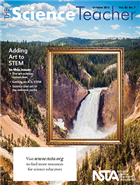 the peer-reviewed journal just for high school teachers; to write for the journal, see our Author Guidelines and Call for Papers; connect on the high school level science teaching list (members can sign up on the list server); or consider joining your peers at future NSTA conferences.
the peer-reviewed journal just for high school teachers; to write for the journal, see our Author Guidelines and Call for Papers; connect on the high school level science teaching list (members can sign up on the list server); or consider joining your peers at future NSTA conferences.
The mission of NSTA is to promote excellence and innovation in science teaching and learning for all. Learn more about the Next Generation Science Standards at the NGSS@NSTA Hub.
Future NSTA Conferences
2016 Area Conferences
Bringing Japan Into My Chicago Classroom
By Guest Blogger
Posted on 2016-10-04
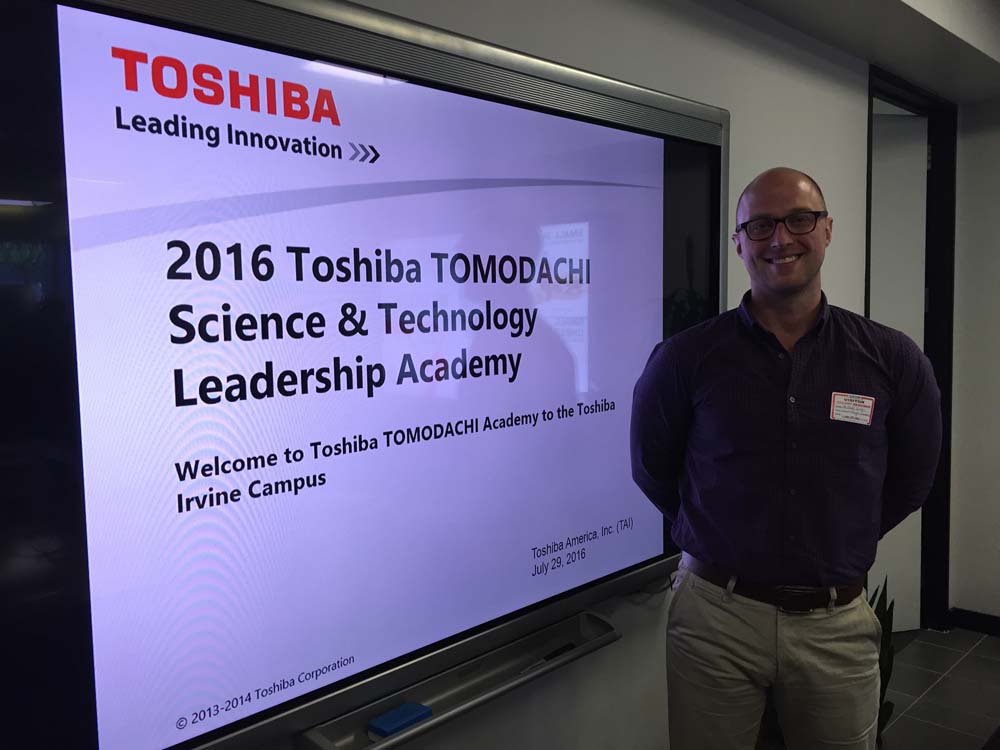
On July 30th, eight high school students and four teachers from the United States traveled to Tokyo to participate in the third annual TOMODACHI Toshiba Science and Leadership Academy. The goal of our trip was to work with Japanese students and teachers on two science and engineering projects that I will also be implementing in my classroom this year. The first project was to build a marble elevator using the engineering and design process and the second project was to use science and technology ideas to improve a real-life community by making it smarter and more disaster-resilient. At the closing ceremonies each group presented their suggestions for one of the following communities: Jakarta, Beijing, Lesbos, or Kuchineorabu-jima.
To help research the community design, our group visited the Toshiba Science Museum to learn more about smart community design and the Tokyo Skytree tower where we learned about earthquake resistant architecture. Taichi Furuhashi from Crisis Mappers Japan brought his drone and spoke with our group about disaster mapping. Students also had the chance to practice 3D mapping by collecting data about the building around the center where we were staying and updating online maps. We also visited the Life Safety Learning Center, a hands-on disaster readiness and prevention facility.
The Tomodachi Initiative was born out of support for Japan’s recovery from the Great East Japan Earthquake of 2011 and walking around Tokyo made it very clear how disaster conscious the city and Japanese people are in the wake of the earthquake. On the sides of construction sites in Harajuku I saw signs in Japanese and English reading “Are you sure and safe? Don’t let earthquakes turn over, knock down, or move the furniture” and markers in subway entrances told you how many meters above sea level you are so you can find higher ground in the event of a tidal wave. Nowhere was this focus on disaster prevention more evident than in the Life Safety Learning Center.
In the center we practiced putting out a fire on a screen using water-filled extinguishers and escaped from a series smoke-filled rooms by staying low to the ground. We also experienced typhoon force winds in a simulator. Unfortunately due to a drought were were not able to don the waterproof boots and jackets and experience the “rain” along with the wind. Just before leaving we took turns experiencing what it feels like to be in a magnitude 7 earthquake on the center’s earthquake simulator, complete with falling foam furniture.
We also watched an informational cartoon about three Japanese children discussing how the next big earthquake could occur at any time. Then, the children magically travel back in time to visit three different earthquake events, one being the Great East Japan Earthquake. With each visit the children learn valuable lessons about being prepared and cooperation during a disaster. The video ends with the children back in their classrooms presenting to their classmates about the importance of being prepared when an earthquake strikes. This is foreshadowed by the students discussing in a previous scene about how the next big earthquake could occur at any time.
I was shocked by how disaster conscious the Japanese culture was. In Chicago we have our students complete a tornado drill every school year, but I could never imagine a disaster learning center in the city nor signs on buildings reminding residents to be prepared for flooding even though it is becoming more and more common in the city. In general, I think in our country we have a tendency to shelter our students and children from the existence of natural disasters rather than prepare them for their inevitable occurrence.
Over the past year our country has been ravaged by massive flooding, record-setting blizzards, and drought-fueled fires, and unfortunately events like these will become more common as the affects of climate change continue to unfold. As science educators, we are in the unique position to discuss these events with our students and challenge them to design new ways to raise awareness and protect against natural disasters.
Inspired by my trip, this year I will be challenging my senior-level environmental science students with the same community redesign challenge that the students completed as part of the Tomodachi Toshiba Science and Leadership Academy. We need to provide our students with more opportunities to solve real-life problems that affect individuals from a local to global level. Not only do these opportunities hook and engage students in the science and engineering practices, but they also open students up to future college and career pathways that they might not have been exposed to otherwise.
NSTA guest blogger Michael Kosko is the Science Chair and Career and Technical Education (CTE) Coordinator at Al Raby School for Community and Environment in Chicago, IL. Kosko teaches environmental science and a STEM design course and runs the school’s hydroponic grow lab and new makerspace. Follow him on Twitter @MrKosko.
For more photos from this year’s TOMODACHI Toshiba Science & Technology Leadership Academy please click here.
The mission of NSTA is to promote excellence and innovation in science teaching and learning for all. Learn more about the Next Generation Science Standards at theNGSS@NSTA Hub.
Future NSTA Conferences
2016 Area Conferences
Follow NSTA

Science Educators Still Feel Budget Strain
By Lynn Petrinjak
Posted on 2016-10-03
Five years ago, 67% of science educators participating in an informal NSTA Reports poll reported their typical school budget for classroom supplies was less than $500, and 27% expected to spend more than $500 of their own money on classroom supplies. This summer, Reports again asked educators about their school budgets, and found only 12% report budget increases over the last five years, while 41% say budgets have decreased, 40% say they haven’t changed, and 7% say they don’t know. A majority (61%) say their typical annual school budget for classroom supplies is less than $500; 13% have budgets between $500 and $1,000; 10% between $1,001 and $1,500; and 16% have budgets that exceed $1,500. Only 25% of educators report their school budgets allow for breakage, upgrades, chemical disposal, and/ or annual repairs and maintenance.
Science educators continue to dip into their own pockets to supply their classrooms and labs: 23% reported spending more than $500 of their own money, and another 21% spent between $301 and $500 last year. They believe that trend will continue, with 31% reporting they expect to spend between $301 and $500 in the current school year, and another 33% estimating they will likely spend $101–$300. Consumable lab supplies were the most common items bought (69%).
To extend budgets, 82% reported they share supplies and equipment with other teachers. In addition, 10% apply for grants at least once a semester, while 18% do so annually. About half (51%) of poll participants said they are able to receive donations of supplies or equipment from local businesses, hospitals, or universities, with 22% unsure if they could.
Educators most often turn to colleagues in the same school or district for budget-friendly ideas for labs (55%); social media such as Twitter and Facebook (53%); NSTA journals and books (37%); and other professional publications (34%). (Respondents could select multiple options.)
The tight budgets are affecting students’ experience: 63% report dropping a planned lab at least once a year because supplies were not affordable. Only 11% of respondents said they have never done so.
Would you like to take part in our anonymous poll on educators’ experiences with substitute teachers?
Here’s how science educators say they try to address budget shortfalls:
Beg, borrow, and plead!—Administrator, Elementary, Colorado
Unfortunately, it’s to drop a lab. —Educator, High School, Illinois
Not my favorite, but the most effective is to ask for donations of everyday objects from students. Most of my parents want to help, but don’t know what the classrooms need.—Educator, Middle School, West Virginia
[I offer] extra credit to students [who] bring in lab supplies that can be found within their homes.—Educator, Middle School, Texas
Using NSTA publications are the best resource for inexpensive lab ideas. —Educator, High School, Institution of Higher Learning, Kentucky
Teaching the kids that we can reuse many items [that] might otherwise be seen as consumables. Shopping sales.—Educator, Elementary, Middle School, Illinois
Buying some items with classroom supply list.—Educator, Middle School, Indiana
I love using Freecycle to ask for supplies.— Educator, Middle School, High School, Colorado
Microscale the labs, and sometimes just [doing] a demonstration (which is not my favorite strategy).—Educator, High School, North Carolina
Alas, it’s not my favorite or preferred strategy, but not doing labs when I don’t have the facilities, materials, and equipment.— Educator, High School, Hawaii
Request private donations from philanthropists.— Educator, Middle School, Texas
Donors Choose.—Educator, Middle School, District of Columbia
Reusable supplies.—Educator, Middle School, Montana Calling supply companies to get discounts.—Educator, High School, Michigan
We ask students to pay a lab fee that helps us increase our budget by a substantial amount.—Educator, Middle School, Kentucky
Keeping a continual classroom wish list.—Educator, Middle School, High School, Texas
Reuse, recycle.—Educator, Elementary, Georgia
Try to pull consumable resources from other departments, such as food resources and office supplies from the office.—Educator, Middle School, Florida
Teams and groups sharing materials; cleaning and reusing; order once and copycat.—Educator, High School, California
Go as cheap as possible. Dollar store is visited frequently.—Educator, Middle School, Texas
Provide students “data” to work with had they been able to collect their own with [a] complete inquiry. Only complete one trial per lab group, and use each group’s results as a trial with class data.—Educator, Middle School, Florida
Using labs that are reusable every year or only require household items. —Educator, Middle School, High School, Oklahoma
Pairing up and group work.—Educator, High School, United Kingdom
Do not order separately; all teachers together, and get a quote from the vendor; usually get free shipping and discounted items!—Educator, High School, California
Change the lesson to one that supports [the] idea, if not the experience. —Educator, Elementary, New Jersey
Buy more in bulk when possible to save on cost.—Educator, High School, Virginia
Planning ahead as much as I can, and asking others in my school or district for donations.—Educator, Elementary, California
Buy at secondhand stores and home improvement stores.—Educator, High School, Washington
Borrow supplies.—Educator, Middle School, Oregon
Demos or larger groups.—Educator, High School, North Carolina
We collaborate as a science team so we don’t double-order materials we can all share.—Educator, Middle School, Illinois
Using [a] unit plan to prioritize equipment and supply needs.—Educator, High School, Maryland
I inherited a pencil machine and collect 25 cents for every pencil. I use this to buy consumables.—Educator, Middle School, Colorado
Larger groups and microscale labs. —Educator, High School, Indiana
Having kids work in groups (as opposed to pairs or threes) to make supplies last longer.—Educator, Elementary, Middle School, Connecticut
Collaborate with colleagues to use [one an]other’s leftovers.—Educator, High School, Michigan
I look for activities and experiments that can be done with the same equipment.— Educator, Middle School, Iowa
Small quantit[ies] with large lab groups. No two-partner groups; typically 4–5 students for one small lab.—Educator, High School, Georgia
Taking a lab that uses an expensive chemical and finding a cheaper local alternative!—Educator, High School, Michigan
As a chemistry teacher, [I have] a simple way to connect my content to my students’ daily lives: …to do labs with kitchen chemicals. They’re usually cheap, and I always get kids who come in the next day and tell me they talked about (or did) the experiment again at home with their family.—Educator, High School, Michigan
Encouraging team members to apply for grants as they become available. —Educator, High School, Texas
This article originally appeared in the September 2016 issue of NSTA Reports, the member newspaper of the National Science Teachers Association. Each month, NSTA members receive NSTA Reports, featuring news on science education, the association, and more. Not a member? Learn how NSTA can help you become the best science teacher you can be.
The mission of NSTA is to promote excellence and innovation in science teaching and learning for all.
Follow NSTA
NSTA's K-12 October 2016 Science Education Journals Online
By Korei Martin
Posted on 2016-10-03
Looking to teach elementary students ways to protect themselves from severe weather with the use of models? Ever thought about incorporating the Earth science processes that students saw during their summer vacations into the classroom? Want to learn how art can liven up your high school science classroom? The October K–12 journals from the National Science Teachers Association (NSTA) have the answers you need. Written by science teachers for science teachers, these peer-reviewed journals are targeted to your teaching level and are packed with lesson plans, expert advice, and ideas for using whatever time/space you have available. Browse the October issues; they are online (see below), in members’ mailboxes, and ready to inspire teachers.
While everyone has the potential to experience a natural hazard, children often have an incomplete view of these phenomena. In this issue, students will see how we can protect ourselves from severe weather and learn to mitigate the impacts of natural hazards by designing solutions through models.
Featured articles (please note, only those marked “free” are available to nonmembers without a fee):
- Complementing Curricula
- In Our Neighborhood: Who’s Been Here?
- Science and Superheroes
- Free – Storm Warning
- Free – Editor’s Note: Natural Hazards
- Full Table of Contents
Students often return to the classroom after visiting spectacular examples of Earth science processes during their summer vacations. Why not ask them to share their best selfies with Earth science phenomena featured in the background before you introduce some of the related activities in this issue of Science Scope?
Featured articles (please note, only those marked “free” are available to nonmembers without a fee):
- The Four Strands of Science Learning and the Next Generation Science Standards
- Teacher’s Toolkit: Puzzle Boxes for 3-D Learning About Natural Hazards
- Free – From the Editor’s Desk: Tying It All Together With Earth Science
- Exploring Lunar and Solar Eclipses Via a 3-D Modeling Design Task
- Free – Earth History Theories: Relative Age Dating Lab With Additions for Mining and Mineral Exploration
- Full Table of Contents
The overlap of science and art can provide rich learning experiences for students. Both science and art help develop careful habits of observation, and both engage students with crosscutting concepts like Patterns, Scale, and Proportion. Science teachers appreciate the value of artwork and creativity every time they assign a poster project, design challenge, or creative writing assignment. Perhaps best of all, including the creative arts in science instruction can help dislodge the common misconception that science is simply a dry, tedious accumulation of facts about the world instead of the imaginative, collaborative enterprise that the history of science shows it to be.
Featured articles (please note, only those marked “free” are available to nonmembers without a fee):
- Sculpting the Barnyard Gene Pool
- Science and Art in the National Parks
- Free – The Art-Science Connection
- Getting an A in STEM
- Free – Editor’s Corner: Science and the Arts
- Full Table of Contents
Get these journals in your mailbox as well as your inbox—become an NSTA member!
The mission of NSTA is to promote excellence and innovation in science teaching and learning for all.
Follow NSTA
From a clock’s ticks in the morning to a father’s snores at night, sounds are everywhere. That’s what an attentive boy discovers as he listens his way through a school day. He perceives that sounds can be loud or soft and low or high. And sometimes, he notices, things like butterflies and wiggling worms are so quiet, he can’t hear them at all.
From a clock’s ticks in the morning to a father’s snores at night, sounds are everywhere. That’s what an attentive boy discovers as he listens his way through a school day. He perceives that sounds can be loud or soft and low or high. And sometimes, he notices, things like butterflies and wiggling worms are so quiet, he can’t hear them at all.
*****
*****




